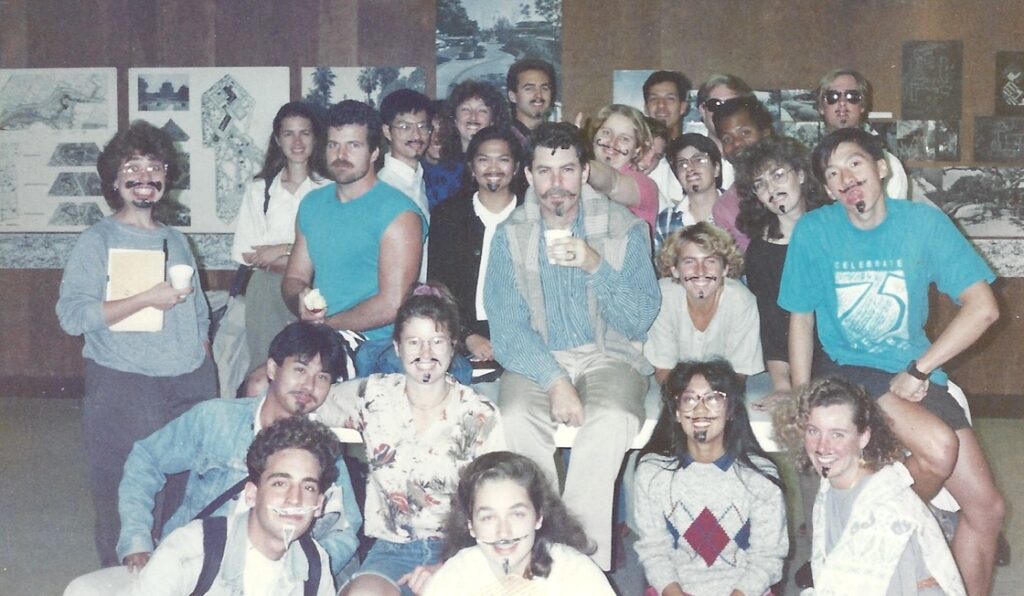The Original Landscape Cartoonist: Artist, landscape architect, champion of drawing Chip Sullivan retires
Professor Charles “Chip” Sullivan, who taught generations of students how to see through drawing in his more than 30 years of innovative teaching in the Department of Landscape Architecture & Environmental Planning at UC Berkeley, retired in June. An artist and landscape architect, Sullivan has long believed in the power of drawing as an essential tool for understanding the complexities of our environment. His advocacy for climate-conscious design has been a continuous thread in his teaching and practice since the beginning of his career.


“Chip’s teaching, art practice, and landscape installations are legendary in the College of Environmental Design. A prolific drawer and thinker, he has inspired generations of students to love art, design, and landscape,” says Chair Walter Hood. “But more importantly, he instills in them a joy and passion for the medium of landscape.”
During his tenure at the College of Environmental Design, Sullivan developed and sustained a unique pedagogy in landscape architecture education. Merging art, nature, and environmental consciousness, his method promotes drawing as a tool of inquiry and research, encouraging students to realize their own creative potential.
In his studios, Sullivan incorporated life drawing, field observation, and hybrid methods of landscape representation. He integrated innovative ideas into his teaching, such as visual note-taking for enhanced comprehension of concepts; using storyboards to understand how to animate and choreograph space; developing optical devices to visualize the landscape; and modeling the landscape with tools like stop-motion animation, set design techniques, and diorama construction.
In recognition of his teaching, Sullivan received the 2016 Jot D. Carpenter Teaching Medal, one of the highest awards the American Society of Landscape Architects presents each year. In 2007, he was recognized for excellence in teaching from the Council of Educators in Landscape Architecture.

Sullivan is the author of numerous award-winning books, most recently Field Sketching for Environmental Designers and Wisdom of Place: A Guide to Recovering the Sacred Origins of Landscape, the latter co-authored with Elizabeth Boults. Sullivan’s Drawing the Landscape, a popular treatise on drawing and the creative process, is now in its fourth edition. Garden and Climate, a detailed analysis of the history of energy-conserving landscape design, received a merit award from the American Society of Landscape Architects.
Inspired by the graphic novel concept, Illustrated History of Landscape Design, co-authored with Elizabeth Boults, uses storyboards, visual narratives, and illustrative timelines to illuminate the history of landscape architecture. Cartooning the Landscape, concerning the metaphysics of drawing and learning how to “see,” received the John Brinckerhoff Jackson prize from the Foundation for Landscape Studies. Other publications include Impulse to Draw: Empowering Imagination for the Electronic Age, co-authored with fellow CED professor Joe Slusky.

Sullivan has been the recipient of multiple fellowships, including a Fellowship in Landscape Architecture at the American Academy in Rome. He received a Rockefeller Foundation grant for residency at the Bellagio Study Center in Lake Como, Italy; a fellowship at the Ligurian Center for the Arts and Humanities in Bogliasco, Italy; and a fellowship to the MacDowell Colony, the renowned arts community in Peterborough, New Hampshire.
Sullivan earned a BA in landscape architecture and a master’s in urban and regional planning from the University of Florida and studied landscape painting and drawing at the Art Students League in New York. He worked as a planner at the Center for the Wetlands in Gainesville, Florida, and as a landscape architect at Sasaki Associates Inc., in Coral Gables and Boston. Early in his career, Sullivan developed a series of experimental gardens that reinterpreted traditional garden forms, applying classical and historical design elements to contemporary landscapes.

Throughout his career, Sullivan has steadfastly maintained the personal work ethic he developed as an undergraduate “to search, experiment, and communicate,” and this philosophy has guided his artistic, academic and professional life. We’re fortunate that he is continuing to teach as an emeritus professor.
Follow him on Instagram at The Original Landscape Cartoonist.